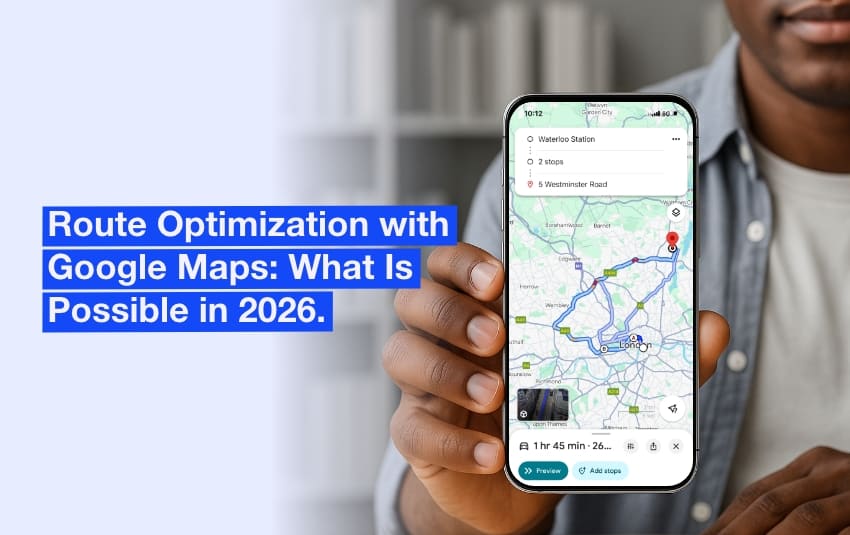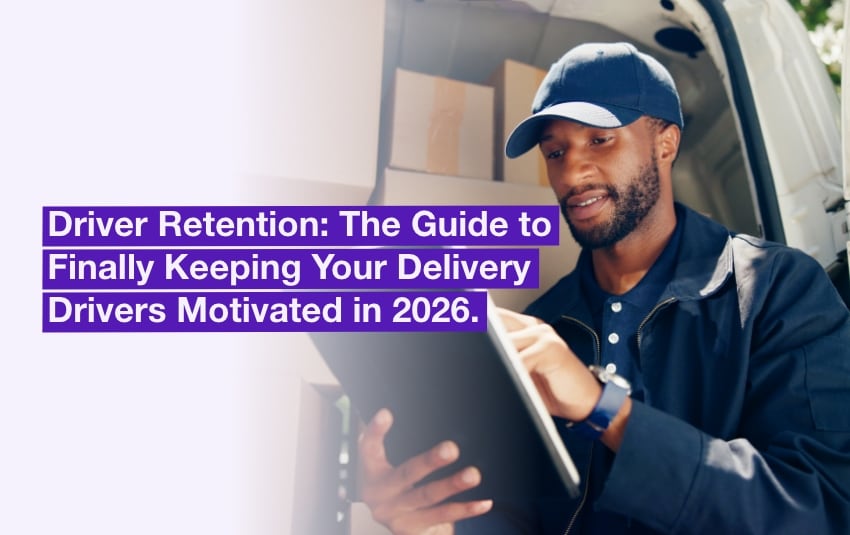Urban freight: how to deliver the city without suffocating it?

The endless flow of vehicles crisscrossing the city to deliver to its businesses and residents is choking it. And yet, these supplies are essential to its survival.
This difficult equation is precisely what urban freight is trying to solve.
Table of contents
- What is urban freight?
- A complex issue involving multiple actors
- The challenges of urban freight in figures
- Solutions being tested to improve the management of last-mile deliveries in cities
To meet the challenges of urban freight logistics, parcel delivery companies need to rethink the way they manage urban deliveries. Innovative software solutions are enabling stakeholders in the supply chain to meet consumer expectations, while at the same time reducing their carbon footprint.
What is urban freight?
“The urban freight is defined as the art of carrying in the best conditions the flows of goods that enter, leave and travel in the city”.
This definition of urban freight, commonly accepted, is the one given in 2009 by researchers Danièle Patier and Jean-Louis Routhier in No. 55 of the Cahiers scientifiques du transport.
In a wider context, urban freight can also be defined as all the flows of goods, people and waste generated by the activities of customers who live or work in cities.
This second definition has the advantage of taking into account individual purchasing practices, i.e., the trips made by consumers who go to a store themselves to buy or return a product.
It also highlights the importance of reverse logistics, corresponding to return flows sent out of the city to be reprocessed in storage or recycling sites.
A complex issue involving multiple actors
The urban freight is a complex issue that involves many public and private actors:
- Logistics providers, their employees and their subcontractors.
- Shippers, i.e. principals who entrust carriers with goods to be transported.
- Manufacturers, retailers and craftsmen who carry out their own shipments.
- The State and local authorities, in particular metropolises and agglomerations.
- People who live in the city or go there to consume goods or services, etc.
Until the 1990s, most stakeholders considered urban freight to be a kind of necessary evil. Public authorities dealt with the issue mainly through bans and regulations, while land developers kept anything that might be a logistics infrastructure as far away from the city as possible.
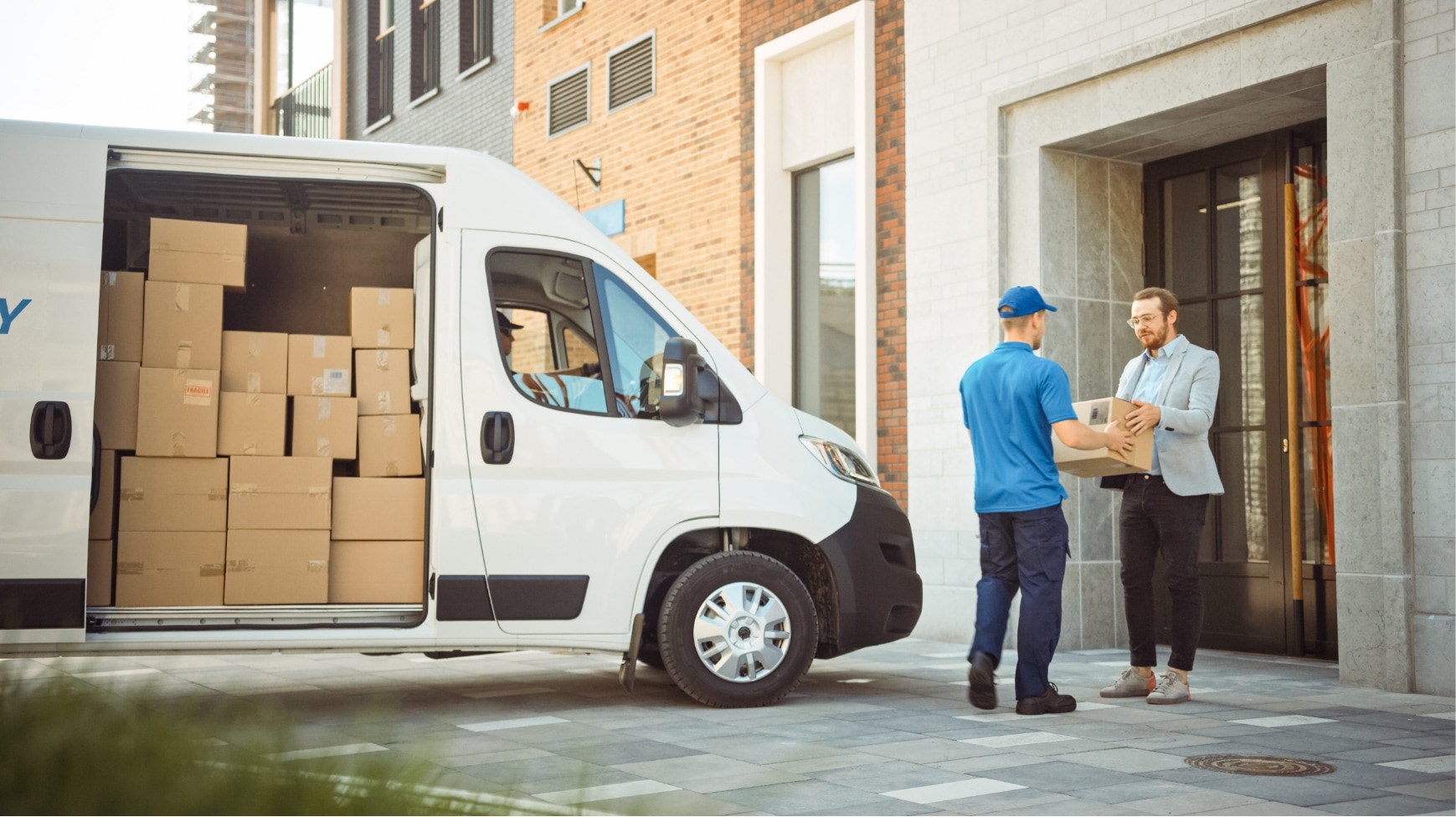
The home delivery of parcels.
But such a policy could not last, at the risk of suffocating the city and paralyzing economic activity.
Due to the evolution of lifestyles and consumption patterns, marked in particular by the rise of e-commerce, a coordinated response from all players became urgent!
The challenges of urban freight in figures
The least we can say is that deliveries in urban areas constitute a major issue, and not only from an economic point of view. These few figures give a better idea of the scale of the problems to be solved.
Environmental and health issues
When we talk about deliveries in the city, we immediately think about their “negative externalities”: air, visual and noise pollution, etc.
The Centre for London, a policy institute which undertakes research and organises events aimed at developing new solutions to London’s critical challenges, reminds us that urban freight alone accounts for:
- 15 % of London’s road network capacity is taken up by freight and logistics vehicles.
- 27 % of fine particulate matter emissions, pollutants that penetrate deep into the body and can cause irritation, asthma, cancer, etc.
- The transportation sector is the 3rd largest greenhouse gas emitter.
In addition, the numerous traffic jams in urban areas further increase the negative effects of transportation on health and the environment. A vehicle caught in traffic jams consumes twice as much fuel and generates 16 times more greenhouse gases than when traffic is free flowing!
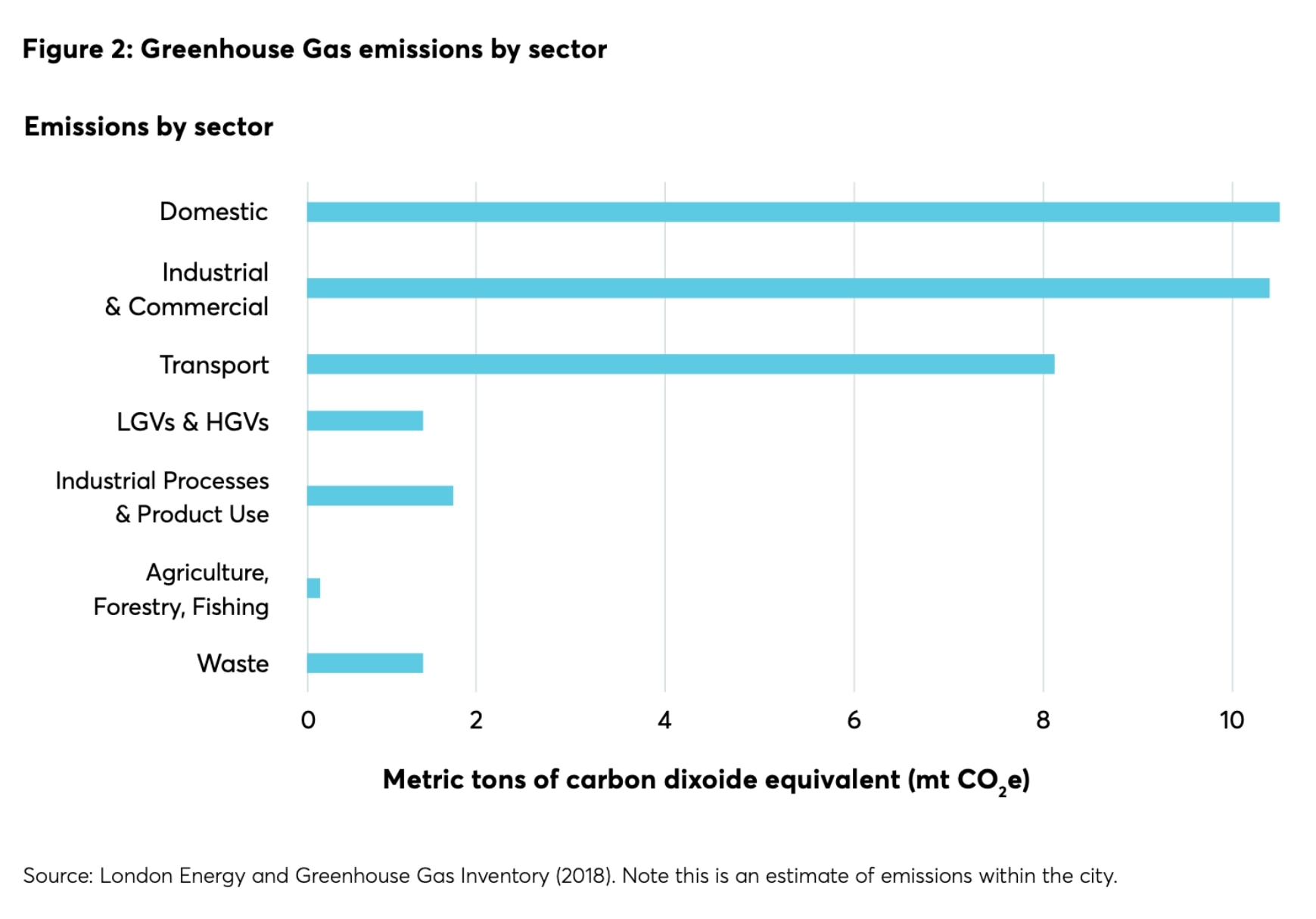
Analysis of carbon emissions in the capital by the Centre for London.
It is therefore becoming urgent for the State and local authorities to find acceptable solutions to prevent cities from suffocating.
Economic issues
According to figures from the Department for Transport quoted in the study Future of Freight: a long-term plan, “The freight and logistics sector is a major contributor to economic activity, productivity, and employment across the whole of the UK and this contribution is growing. Since 2010, the number of jobs in transport and storage has grown by 26%“.
The direct impact of this economic sector on employment is therefore significant.
The delivery in urban areas also generates significant costs for companies. According to several studies, this part accounts for one third of the total logistics cost of transporting goods that may have travelled thousands of kilometers beforehand.
However, carriers’ room for maneuver is tenuous, as “the various players in the chain are often not very profitable” the same report warns. In 2016, the accounts of courier and express companies showed an operating profit of around 2 percent, roughly the same as that of subcontractors.
If we add to this the recent rise in the cost of fuel, we can better measure the structural fragility of the players in this sector.
Social issues
Some jobs in the logistics sector are precarious or very poorly paid – and not only the jobs of bicycle delivery drivers. This is the famous uberization of the sector, encouraged by an even higher rate of subcontracting in urban areas.
According to Oliver Wyman’s figures, on the last mile between the final warehouse and the final consumer, 70 to 80% of the goods are entrusted to an external service provider. In the polite words of this report, outsourcing is a tool of choice “to shift some of the social management constraints to subcontractors”.
A free-flowing and efficient urban freight system is essential for the proper functioning of society as a whole.

The electronic signature of the delivery note.
In France, the report of the LUD Logistique urbaine durable (Sustainable Urban Logistics in English) mission reminds us that this link in the logistics chain “provides a living for shops, industries, offices, schools (school canteens)” and therefore affects the lives of citizens, both indirectly and directly.
Without an appropriate logistics solution, it would be impossible to keep a hospital, a retirement home or even a jail running on a daily basis!
Solutions being tested to improve the management of last-mile deliveries in cities
To meet these challenges, many initiatives and experiments are being carried out, often involving public and private partners.
Among them, these 5 solutions seem particularly promising.
Developing logistics areas in cities
Transporting a 7.5 ton payload with a truck that is 90% full is much less polluting than moving seven commercial vehicles that are 70% full, while taking up much less space.
The European Commission figures quoted by Olivier Wyman are totally counter-intuitive, and yet!
Depending on the particle filtering technology used, a heavy goods vehicle will emit “only” 160 to 250 g of carbon dioxide to transport one ton over one kilometer, compared to 380 to 450 g for commercial vehicles.

Comparison of HGV / LCV capacity, ground surface area, CO2 emissions by Olivier Wyman.
However, distribution services must have suitable urban freight areas:
- Platforms of at least 2 ha as close as possible to the cities to be supplied.
- Smaller distribution centers within the city.
- Local logistics areas such as goods or vehicle drop-off locations in each neighborhood.
The Center for London suggests that in order to reduce the travel mileage for delivery vehicles, it is crucial for the British Capital to maintain available space for logistics hubs near to residential areas.
To achieve this, Local Authorities, in accordance with the London Plan, should should continue to protect land designated for logistics throughout London. The Authorities should also collaborate with delivery businesses to find out where are the areas with the highest demand for logistics hubs. In this way, they can effectively support applications for new premises near residential areas.
According to the Centre for London, the Councils should allow quiet deliveries to take place during evenings and the night-time.
Encouraging transporters to invest in green vehicles
However, with the increasing fragmentation of flows, the use of heavy vehicles is not always relevant. When the quantity to be delivered or the distance to be covered is smaller, it is better to encourage carriers to make their fleet carbon-free:
- Electric or hybrid vehicles
- NGV or bioNGV trucks
- Cargo bicycles, etc.
“Few businesses were using electric vans to their full extent, but several were considering it or were in the process of upgrading their fleet.” To offset the higher total cost of ownership of green vehicles and accelerate fleet renewal, the national government should fund upgrades to power distribution networks, and charging facilities in private and commercial premises such as depots.
The United Kingdom is developing projects for this. The total funding committed by the UK government to vehicle grants and infrastructure is now at £2.5 billion.
The Workplace Charging Scheme (WCS) is a voucher-based scheme for companies for electric car charger installation. It can cover up to 75% of the cost and a maximum of £350 for each socket, for up to 40 sockets.
Improving the management of delivery areas
In London, the parking restrictions stop vehicles parking illegally in delivery bays. However, the lack of available legal parking means that delivery operators sometimes park illegally and have to pay penalty charge notices.
The government could therefore be inspired by the actions suggested by the InTerLUD mission about the management of delivery areas in France.
The first project consists in extending the decriminalization of parking to delivery areas. In concrete terms, when a private individual parks in a delivery area, he or she is currently only risking a fine, which is not very dissuasive.
Once this system is adopted, the local police or external service providers will be able to impose post-parking or post-stop charges (beyond a maximum stopping time to be defined).
In addition, the government is working on another proposal of the InTerLUD mission, which consists of aggregating and making available in the form of open data all the statistics about the:
- Delivery areas
- Traffic regulations
- Parking regulations, etc.
Certainly, the subject may seem a bit technical. But such a project would really facilitate the daily life of delivery drivers and carriers, who would have all the information they need to optimize their stops and deliveries via an application like AntsRoute for example!
Increasing the parcel pickup solutions
According to the study Worth the Weight: Making London’s deliveries greener and smarter, the number of parcels delivered in London is expected to double by 2030 as the shift to e-commerce continues.
To reduce the environmental impact of parcel deliveries in the city, another solution is to further increase the number of shared pickup points such as parcel relays or secure lockers:
- Locker Amazon
- InPost Lockers
- DPD Pickup Lockers, Hermes, etc.
This distribution method is highly appreciated by consumers for its flexibility and also avoids failed deliveries due to customer absence. However, this same study estimates that 13-14% of all online shopping deliveries arrive either late or when the customer is not at home: a huge environmental waste!
Optimizing parcel delivery routes
Another simple measure to optimize the distribution of goods and offer greener deliveries is to adopt a route management software.
Available as both online software and a mobile app, these tools are very useful for efficiently organizing your delivery routes and reducing your carbon footprint.
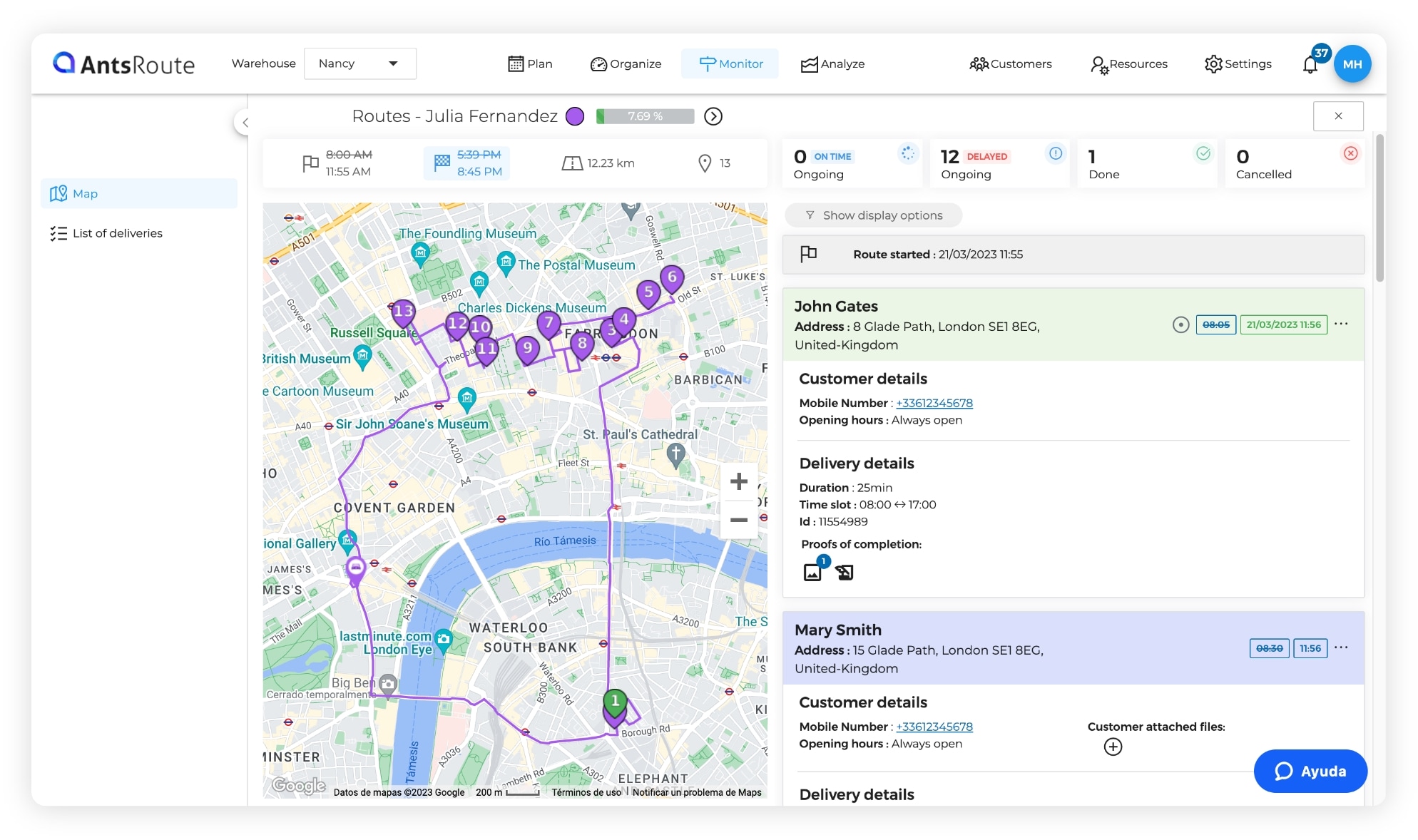
The interface of the AntsRoute route optimization software.
A solution like AntsRoute, for example, includes many features to reduce the ecological and economic cost of the last mile:
- Geographical optimization of routes according to the type of engine.
- Consideration of ULEZ (Ultra Low Emission Zone).
- Module for maximizing vehicle loading.
- Prioritization of greener vehicles: electric car or bicycle, NGV truck, etc.
- Notifications by email or SMS to alert the end customer’s absences, etc.
Does your fleet include one or more 100% electric vehicles? Thanks to powerful algorithms, our solution allows the optimization of customized routes: level of battery life, state of charge thresholds, location of charging stations, etc.
To take advantage of a free trial of our solution for 7 days, just fill in your details. Go to this page.
Free 7-day trial | No credit card required
Contenu
- What is urban freight?
- A complex issue involving multiple actors
- The challenges of urban freight in figures
- Environmental and health issues
- Economic issues
- Social issues
- Solutions being tested to improve the management of last-mile deliveries in cities
- Developing logistics areas in cities
- Encouraging transporters to invest in green vehicles
- Improving the management of delivery areas
- Increasing the parcel pickup solutions
- Optimizing parcel delivery routes




